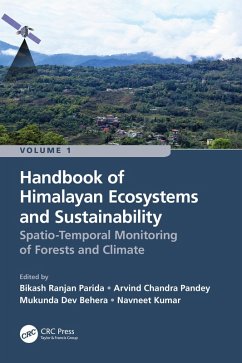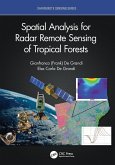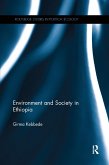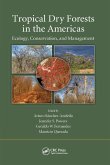Handbook of Himalayan Ecosystems and Sustainability, Volume 1
Spatio-Temporal Monitoring of Forests and Climate
Herausgeber: Parida, Bikash Ranjan; Behera, Mukunda Dev; Pandey, Arvind Chandra
Handbook of Himalayan Ecosystems and Sustainability, Volume 1
Spatio-Temporal Monitoring of Forests and Climate
Herausgeber: Parida, Bikash Ranjan; Behera, Mukunda Dev; Pandey, Arvind Chandra
- Broschiertes Buch
- Merkliste
- Auf die Merkliste
- Bewerten Bewerten
- Teilen
- Produkt teilen
- Produkterinnerung
- Produkterinnerung
With advanced remote sensing and GIS tools, in-depth analyses, and interdisciplinary approaches, this volume studies forest degradation caused by fires, analyses vegetation trends and seasonal changes, vegetation productivity, endemic species, and the impact of climate change. A collection of Himalayan case studies on landscape restoration.
Andere Kunden interessierten sich auch für
![Spatial Analysis for Radar Remote Sensing of Tropical Forests Spatial Analysis for Radar Remote Sensing of Tropical Forests]() Gianfranco D de GrandiSpatial Analysis for Radar Remote Sensing of Tropical Forests76,99 €
Gianfranco D de GrandiSpatial Analysis for Radar Remote Sensing of Tropical Forests76,99 €![Environment and Society in Ethiopia Environment and Society in Ethiopia]() Girma KebbedeEnvironment and Society in Ethiopia65,99 €
Girma KebbedeEnvironment and Society in Ethiopia65,99 €![Veins of the Desert Veins of the Desert]() Ali Asghar Semsar YazdiVeins of the Desert55,99 €
Ali Asghar Semsar YazdiVeins of the Desert55,99 €![From the Forest to the Sea - Public Lands Management and Marine Spatial Planning From the Forest to the Sea - Public Lands Management and Marine Spatial Planning]() Morgan GopnikFrom the Forest to the Sea - Public Lands Management and Marine Spatial Planning69,99 €
Morgan GopnikFrom the Forest to the Sea - Public Lands Management and Marine Spatial Planning69,99 €![Geography of Climate Change Geography of Climate Change]() Geography of Climate Change50,99 €
Geography of Climate Change50,99 €![Tropical Dry Forests in the Americas Tropical Dry Forests in the Americas]() Tropical Dry Forests in the Americas92,99 €
Tropical Dry Forests in the Americas92,99 €![Working with Map Projections Working with Map Projections]() Fritz KesslerWorking with Map Projections111,99 €
Fritz KesslerWorking with Map Projections111,99 €-
-
-
With advanced remote sensing and GIS tools, in-depth analyses, and interdisciplinary approaches, this volume studies forest degradation caused by fires, analyses vegetation trends and seasonal changes, vegetation productivity, endemic species, and the impact of climate change. A collection of Himalayan case studies on landscape restoration.
Hinweis: Dieser Artikel kann nur an eine deutsche Lieferadresse ausgeliefert werden.
Hinweis: Dieser Artikel kann nur an eine deutsche Lieferadresse ausgeliefert werden.
Produktdetails
- Produktdetails
- Verlag: Taylor & Francis Ltd (Sales)
- Seitenzahl: 376
- Erscheinungstermin: 1. Oktober 2022
- Englisch
- Abmessung: 234mm x 156mm x 21mm
- Gewicht: 553g
- ISBN-13: 9781032214306
- ISBN-10: 1032214309
- Artikelnr.: 71795345
- Herstellerkennzeichnung
- Libri GmbH
- Europaallee 1
- 36244 Bad Hersfeld
- gpsr@libri.de
- Verlag: Taylor & Francis Ltd (Sales)
- Seitenzahl: 376
- Erscheinungstermin: 1. Oktober 2022
- Englisch
- Abmessung: 234mm x 156mm x 21mm
- Gewicht: 553g
- ISBN-13: 9781032214306
- ISBN-10: 1032214309
- Artikelnr.: 71795345
- Herstellerkennzeichnung
- Libri GmbH
- Europaallee 1
- 36244 Bad Hersfeld
- gpsr@libri.de
Bikash Ranjan Parida is an assistant professor at Central University of Jharkhand (CUJ), India since September 2016. He earned his M.Sc. in Geoinformatics (2006) from the University of Twente and his PhD from the University of Hamburg/ Max Planck Institute for Meteorology (2011). Prior to joining CUJ, he was employed by various premium institutes involved in Earth and Environmental studies He has contributed to several national research projects such as Science and Engineering Research Board (SERB) under the Department of Science and Technology (DST), Start-Up Research Grant by UGC, NISAR project by SAC, Ahmedabad, ISRO. He has more than 40 research publications in peer-reviewed journals. A.C. Pandey is a professor in the Department of Geoinformatics at Central University of Jharkhand (CUJ), India. He is the former Head of the Department of Geoinformatics (2013-2020) and the former Dean of the School of Natural Resource Management (2013-2016) at CUJ. He has been the CUJ Coordinator for ISRO and EDUSAT program since 2013. From 2004-2013 he was an associate professor of Remote Sensing in Birla Institute of Technology. He earned his Ph.D. degree in Geology from Department of Geology at the University of Delhi in 2001. He has published more than 70 articles and two edited books. He is the recipient of NASA-SERVIR Fellowship in 2013 to work on Himalayan glaciers in Zanskar Valley, J&K. Mukunda Dev Behera has made outstanding contributions to the fields of forest remote sensing and ecological climatology. His research innovations have fundamentally transformed the study of phytogeography, with attention to ecological functioning of three ecosystem components, plant diversity-water-energy. Dr. Behera has been a Guest Editor for six special issues and has served in three editorial boards of Springer's journals: Biodiversity and Conservation, Environmental Monitoring and Assessment, and Tropical Ecology. With over 20-year research and teaching experience, he has published over 100 articles. Navneet Kumar is a senior researcher at the Center for Development Research (ZEF), University of Bonn in Germany. He earned his PhD in Engineering from the University of Bonn. His main research fields are water and natural resources management and Geoinformatics. Dr. Kumar has contributed to several projects in Algeria, Ethiopia, India, Mali, Niger and Uzbekistan. These projects include research on the impact assessment of climate change and land use change. He has presented his work in several international conferences and has published with several journals.
Introduction to Himalaya. Section 1- Geospatial Perspective for Monitoring
Himalayan Ecosystem. Monitoring Land Use and Land Cover Dynamics Across the
Himalayas from 1985 to 2019. Assessment of the Effects of LULC Changes on
Surface Temperature. Shifting Cultivation Dynamics of Northeastern India.
Monitoring Tea Plantations Dynamics (2000-2020) Using Satellite Data in
Dooars Regions of Himalaya. Disentangle the Short and Long -Term Forest
Degradation Over Most Fire Affected Parts of Western Himalaya, India.
Potential of Spaceborne Bistatic Polarimetric Interferometric SAR Modelling
for Vegetation Height Estimation. Section 2 - Monitoring Vegetation
Productivity and Climate Change. Estimating Aboveground Biomass of Sal and
Teak Forests Using Terrasar-X and Semi-Empirical Model in Part of Terai
Himalaya. Spatial Distribution of GPP Over Croplands Using Planetscope
Imagery in Majuli Islands, Assam. Vegetation Trend Analysis and Seasonal
Change Estimation Based on Time-Series Satellite Data for Northeast India.
Century-Scale Variations in Vegetation Greenness and Productivity in
Central Himalaya. Climatic Control of High-Latitude Vegetation Monotonic
Greening and Browning Trends Across the Himalayas and Anthropogenic Effect.
Climate Forcing on Photosynthetic Variability Across Relief Zones in the
Himalayas. Section 3 - Forest Fire and Landscape Restoration. Appraisal of
Forest Fire Risk Through Geospatial Techniques in Uttarakhand Himalayan
Region. Changing Pattern of Forest Fire Regime in Relation to Climatic
Oscillation Over Western and Eastern Himalaya, India. Forest Fuel Bed
Mapping in Sikkim Himalaya. Floristic Shifting of Endemic Species in
Eastern Himalayas due to Climate Change. Landscape Restoration in Indian
Himalayan Region.
Himalayan Ecosystem. Monitoring Land Use and Land Cover Dynamics Across the
Himalayas from 1985 to 2019. Assessment of the Effects of LULC Changes on
Surface Temperature. Shifting Cultivation Dynamics of Northeastern India.
Monitoring Tea Plantations Dynamics (2000-2020) Using Satellite Data in
Dooars Regions of Himalaya. Disentangle the Short and Long -Term Forest
Degradation Over Most Fire Affected Parts of Western Himalaya, India.
Potential of Spaceborne Bistatic Polarimetric Interferometric SAR Modelling
for Vegetation Height Estimation. Section 2 - Monitoring Vegetation
Productivity and Climate Change. Estimating Aboveground Biomass of Sal and
Teak Forests Using Terrasar-X and Semi-Empirical Model in Part of Terai
Himalaya. Spatial Distribution of GPP Over Croplands Using Planetscope
Imagery in Majuli Islands, Assam. Vegetation Trend Analysis and Seasonal
Change Estimation Based on Time-Series Satellite Data for Northeast India.
Century-Scale Variations in Vegetation Greenness and Productivity in
Central Himalaya. Climatic Control of High-Latitude Vegetation Monotonic
Greening and Browning Trends Across the Himalayas and Anthropogenic Effect.
Climate Forcing on Photosynthetic Variability Across Relief Zones in the
Himalayas. Section 3 - Forest Fire and Landscape Restoration. Appraisal of
Forest Fire Risk Through Geospatial Techniques in Uttarakhand Himalayan
Region. Changing Pattern of Forest Fire Regime in Relation to Climatic
Oscillation Over Western and Eastern Himalaya, India. Forest Fuel Bed
Mapping in Sikkim Himalaya. Floristic Shifting of Endemic Species in
Eastern Himalayas due to Climate Change. Landscape Restoration in Indian
Himalayan Region.
Introduction to Himalaya. Section 1- Geospatial Perspective for Monitoring
Himalayan Ecosystem. Monitoring Land Use and Land Cover Dynamics Across the
Himalayas from 1985 to 2019. Assessment of the Effects of LULC Changes on
Surface Temperature. Shifting Cultivation Dynamics of Northeastern India.
Monitoring Tea Plantations Dynamics (2000-2020) Using Satellite Data in
Dooars Regions of Himalaya. Disentangle the Short and Long -Term Forest
Degradation Over Most Fire Affected Parts of Western Himalaya, India.
Potential of Spaceborne Bistatic Polarimetric Interferometric SAR Modelling
for Vegetation Height Estimation. Section 2 - Monitoring Vegetation
Productivity and Climate Change. Estimating Aboveground Biomass of Sal and
Teak Forests Using Terrasar-X and Semi-Empirical Model in Part of Terai
Himalaya. Spatial Distribution of GPP Over Croplands Using Planetscope
Imagery in Majuli Islands, Assam. Vegetation Trend Analysis and Seasonal
Change Estimation Based on Time-Series Satellite Data for Northeast India.
Century-Scale Variations in Vegetation Greenness and Productivity in
Central Himalaya. Climatic Control of High-Latitude Vegetation Monotonic
Greening and Browning Trends Across the Himalayas and Anthropogenic Effect.
Climate Forcing on Photosynthetic Variability Across Relief Zones in the
Himalayas. Section 3 - Forest Fire and Landscape Restoration. Appraisal of
Forest Fire Risk Through Geospatial Techniques in Uttarakhand Himalayan
Region. Changing Pattern of Forest Fire Regime in Relation to Climatic
Oscillation Over Western and Eastern Himalaya, India. Forest Fuel Bed
Mapping in Sikkim Himalaya. Floristic Shifting of Endemic Species in
Eastern Himalayas due to Climate Change. Landscape Restoration in Indian
Himalayan Region.
Himalayan Ecosystem. Monitoring Land Use and Land Cover Dynamics Across the
Himalayas from 1985 to 2019. Assessment of the Effects of LULC Changes on
Surface Temperature. Shifting Cultivation Dynamics of Northeastern India.
Monitoring Tea Plantations Dynamics (2000-2020) Using Satellite Data in
Dooars Regions of Himalaya. Disentangle the Short and Long -Term Forest
Degradation Over Most Fire Affected Parts of Western Himalaya, India.
Potential of Spaceborne Bistatic Polarimetric Interferometric SAR Modelling
for Vegetation Height Estimation. Section 2 - Monitoring Vegetation
Productivity and Climate Change. Estimating Aboveground Biomass of Sal and
Teak Forests Using Terrasar-X and Semi-Empirical Model in Part of Terai
Himalaya. Spatial Distribution of GPP Over Croplands Using Planetscope
Imagery in Majuli Islands, Assam. Vegetation Trend Analysis and Seasonal
Change Estimation Based on Time-Series Satellite Data for Northeast India.
Century-Scale Variations in Vegetation Greenness and Productivity in
Central Himalaya. Climatic Control of High-Latitude Vegetation Monotonic
Greening and Browning Trends Across the Himalayas and Anthropogenic Effect.
Climate Forcing on Photosynthetic Variability Across Relief Zones in the
Himalayas. Section 3 - Forest Fire and Landscape Restoration. Appraisal of
Forest Fire Risk Through Geospatial Techniques in Uttarakhand Himalayan
Region. Changing Pattern of Forest Fire Regime in Relation to Climatic
Oscillation Over Western and Eastern Himalaya, India. Forest Fuel Bed
Mapping in Sikkim Himalaya. Floristic Shifting of Endemic Species in
Eastern Himalayas due to Climate Change. Landscape Restoration in Indian
Himalayan Region.








